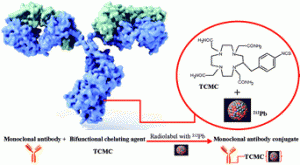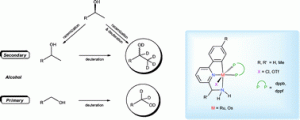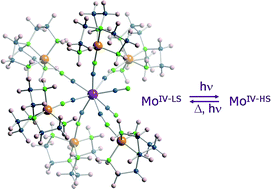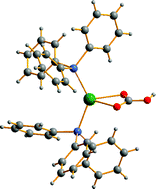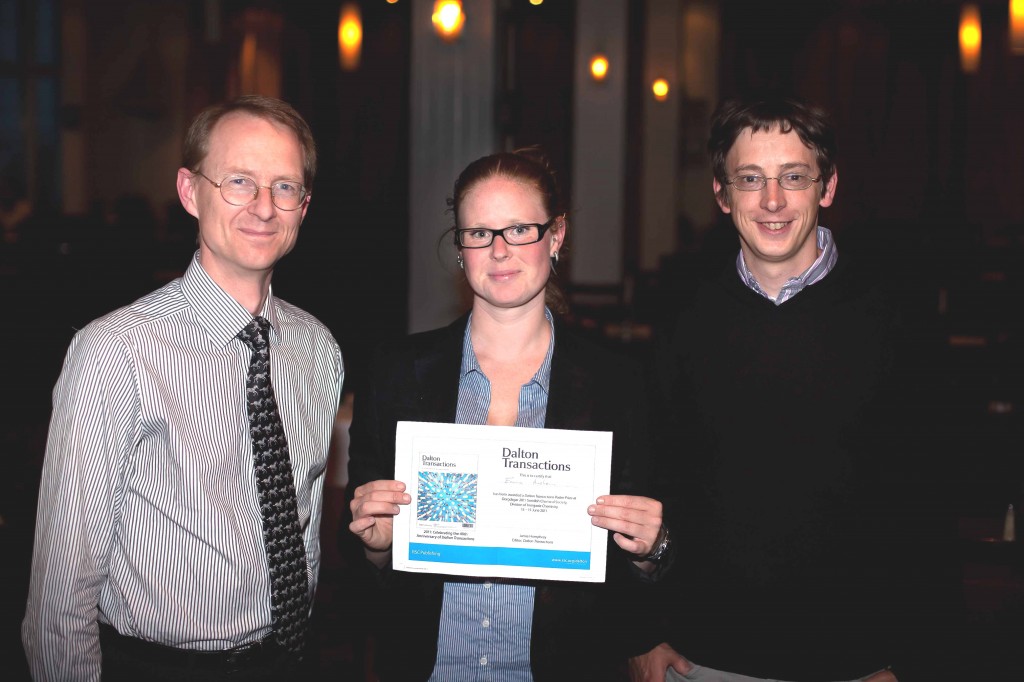
Ms Aneheim flanked by conference organisers Prof Lars Öhrström, Chalmers Tekniska Högskola (left) and Dr Christopher Knee, University of Gothenburg. Photo credit: Magnus T. Johnson
The inorganic chemistry division of the Swedish Chemical Society held their ‘Oorgdagar 2011’ last week. This meeting brings together researchers in inorganic chemistry, from organometallic chemistry to materials chemistry, in Sweden and Scandinavia. To find out more visit the inorganic chemistry division’s webpage, or see Jamie’s earlier blog.
Dalton Transactions was pleased to sponsor a poster prize at the meeting, which was awarded to Emma Aneheim, a phd student at Chalmers University of Technology in Göteborg, Sweden. Ms Aneheim’s poster was on ‘Palladium chemistry in the advanced reprocessing of spent nuclear fuel’. Find out more about her research by visiting Emma’s webpage at the Department of Nuclear Chemistry.
Conference organiser Prof Lars Öhrström was very enthusiastic about how well the meeting went, commenting ‘it was a great success with speakers from the UK, Germany, Finland, South Africa, France, USA as well as Sweden. The next (second) meeting will be held in Lund 2013’
Comments Off on Oorgdagar 2011 Swedish Chemical Society, Division of Inorganic Chemistry Meeting












 In this HOT article, a very careful synthetic and catalytic study of the use of di- and trisulfonated phosphines with o, m and o, m, m substitution patterns is described. Pd complexes of these were tested for copolymerizations with polar monomers. This led to a novel anionic phosphine sulphonate Pd(II)-based pre-catalyst salt for polymerisation reactions. Although, polymerisation in the presence of methyl acrylate, acrylonitrile and vinyl acetate led to reduced incorporation values compared to the available literature reports in combination with problems that are attributed to aggregation of the catalyst in most cases, the facile synthesis of chelating highly polar ligands which show high water solubility could be of significant interest for homogeneous catalysis by application in other systems.
In this HOT article, a very careful synthetic and catalytic study of the use of di- and trisulfonated phosphines with o, m and o, m, m substitution patterns is described. Pd complexes of these were tested for copolymerizations with polar monomers. This led to a novel anionic phosphine sulphonate Pd(II)-based pre-catalyst salt for polymerisation reactions. Although, polymerisation in the presence of methyl acrylate, acrylonitrile and vinyl acetate led to reduced incorporation values compared to the available literature reports in combination with problems that are attributed to aggregation of the catalyst in most cases, the facile synthesis of chelating highly polar ligands which show high water solubility could be of significant interest for homogeneous catalysis by application in other systems.